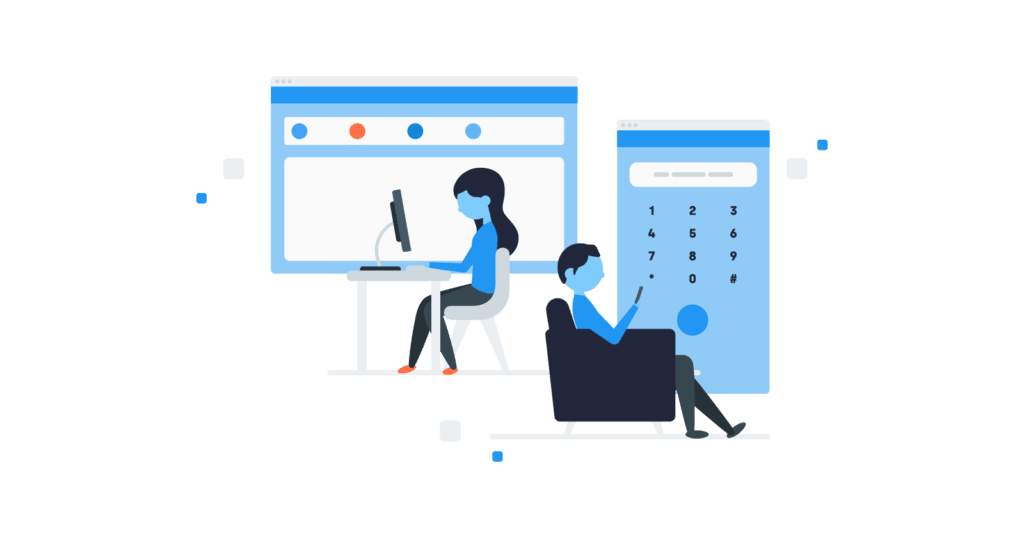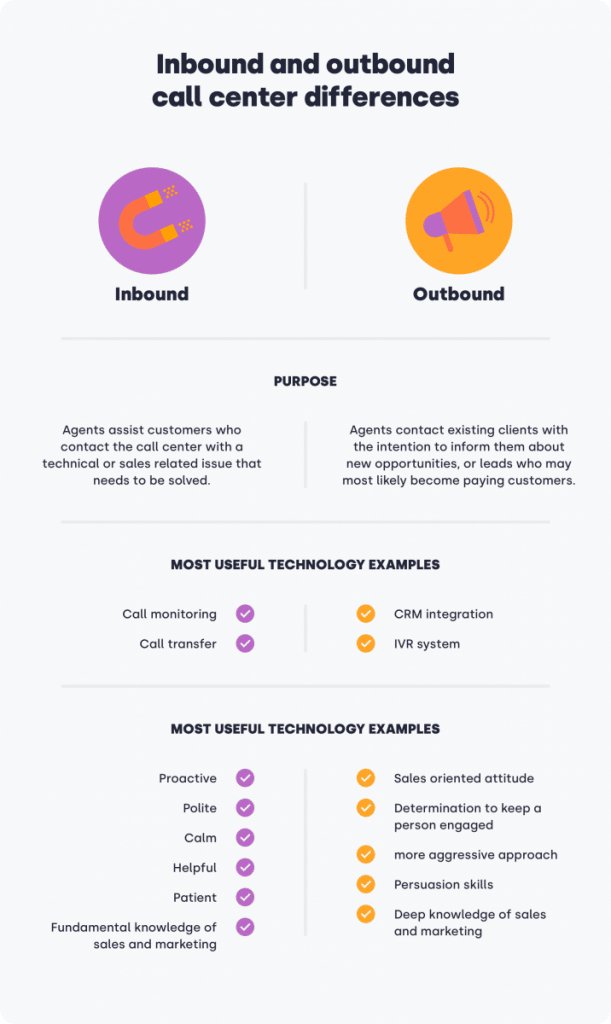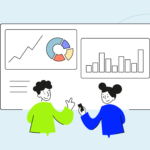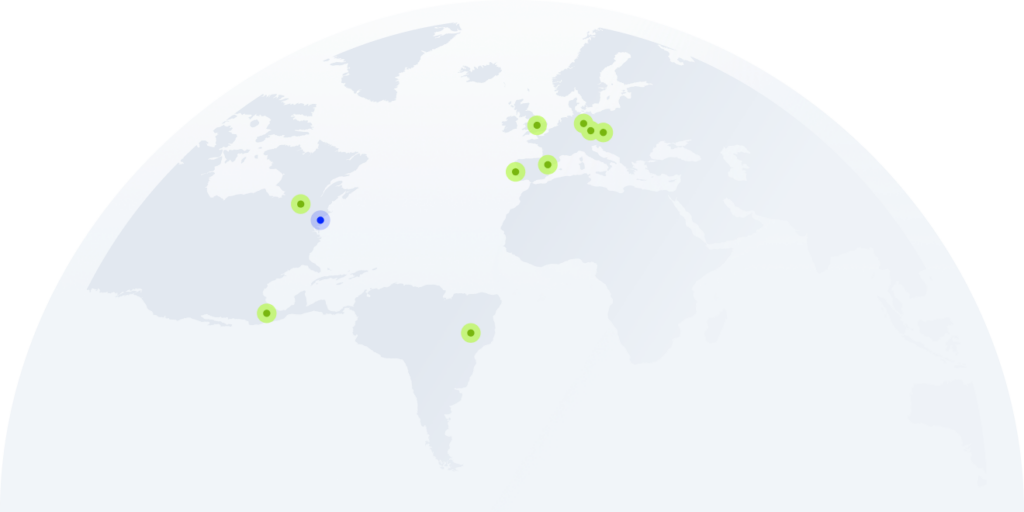Do you know the difference between inbound and outbound call centers?

Customer service is constantly changing. And there is a need for it, since 54 % of all consumers from all over the globe claim that they have higher expectations from customer support year by year. Both inbound and outbound call centers offer great opportunities to build positive relationships with customers.
Each of them is different in purpose, technology and approach, yet they are most efficient when they work together. In this blog, you will find everything you need to know about these two call center models.
What is an inbound call center?
An inbound call center, as the name suggests, focuses on incoming requests. Agents are waiting for customers to contact them. Therefore, the inbound call center model is more customer service oriented than an outbound one and covers many platforms, such as phone calls, emails, SMS, social media or still more and more popular Live Chat.
The main role is to improve overall customer experience through providing meaningful help – assisting with customers’ issues, answering their questions, dealing with orders or solving complaints. Having a quality inbound call center is of great importance for companies of each size. In fact, around 89 % of companies expect to compete with their concurrence mostly based on customer experience.
To make the communication more efficient for customers, as well as for agents, inbound call centers incorporate many useful SaaS call center software solutions. These help to handle dozens of inquiries.
Examples of such tools are interactive voice responses, call forwarding, voice mails or customer call history database. The last one is especially useful, since 72 % of consumers claim that when contacting customer service, they expect that the agent already knowsthem and is acquainted with their previous engagements.
Learn about outbound sales in our ultimate guide
Most common types of inbound call center services
#1 Customer service
Customer service is basically a safety net for customers who consider purchasing your product or already have done so. If any issue arises, they seek a knowledgeable service representative. Customer service agents are trained professionals who most often take care of less technical issues, such as:
- Feedbacks
- Returns
- Payments
- Address changes
- Questions about policies or practices
You need to understand how important it is to have excellent customer service agentswho provide your clients with great experiences. Negative impression may lead to churn, robbing you of most faithful customers. In fact, around 68 % of people leave the service because of a bad customer service experience. And as you may know, keeping and nurturing existing customers is much cheaper for your business, since acquiring new onesmay cost 6 to 7 times more.
#2 Technical support
This type of service is more technical than a standard customer service. Technical support representatives are familiar with each aspect of how the product works, in order to provide prompt and satisfying technical assistance.
For these agents, it is necessary to have a great amount of patience, since solving some technical issues may take a significant amount of time.
If an issue occurs that goes beyond the power of technical support, agents escalate to superiors or developers.
#3 Inbound Sales
Another name for Inbound sales is pre-sales, which indicates that an intention of the customer is to find out more about the product before making a purchase decision.
Since the prospect is seeking for more information, it is very probable that he has a serious interest in the product. Therefore, inbound call center agents need to do their best in order to turn this opportunity into an actual profit while making the customer feel special.
In the end, customers are willing to pay 25 % more money to work with a company who provides an exceptional customer experience. The ability to actually move a potential customer all the way through the sales funnel requires a great people skills and knowledge of sales and marketing strategies.
What is an outbound call center?
In contrast to Inbound call centers, outbound call centers are focused almost solely on outgoing calls, with more emphasis on sales than on customer service. The aim of outbound agents is to reach out customers and leads in order to let them know about companies’ products or inspire them to purchase upgraded services. Agents usually work with a contact list. This allows them to contact the right people.
Most common types of outbound call center services
#1 Lead generation
98% of people claim they strongly dislike telemarketing calls from random companies that they have never heard of who offer products that they don’t even care about. In a digital age, there are much more effective practices of acquiring leads, by selecting those who already showed an interest in a business. Highly-targeted prospect lists are one of the main traits of modern outbound lead generation, which is currently used mostly by B2B companies.
Inbound call centers may then aim for cold calling to those potential customers who visited a website, took a survey, etc. They can also bet on warm calling to already active customers, introducing them to new offers.
This way, there is a higher probability to reach the right customers, as well as much less work for call center agents.
#2 Market research
The lion’s share of statistics on the internet comes from outbound call center market research. This type of outbound call center practice is crucial for getting to know your customers, making informed decisions and developing your business.
One of the most popular methods is telephone focus groups. In this case, the experienced marketing research operator calls the participants and interviews them. It’s a handy way to collect information, as questions can be answered from anywhere. Your agent needs to have effective communication skills to establish a quick connection with a customer.
The calls are usually recorded using call center softwares. Focus groups typically involve people who haven’t used the product before, but not necessarily.
Types of market research aims:
- Collecting information about customer preferences
- Monitoring awareness of product or service campaigns
- Collecting user experience stories
- Researching impression of your business’ services
- Discovering lead’s’ knowledge of competitor’s products
#3 Customer retention
How can you find out if your current clients are happy and would like to continue using your services?
You can simply ask them. Follow-up calls are made to measure the customer’s experience, see what went well and what can be improved. It’s both a source of valuable information and a way to show customers that you genuinely care about what they think.
Inbound versus Outbound Call Center: What Are the Main Differences?
Here are three lead aspects that differentiate inbound and outbound call centers:
#1 Purpose
Inbound call center: Agents are assisting customers who, by themselves, contact the help center. Either because they have a technical or sales related issue, or maybe they just want to ask about the product, either after or before purchasing. Inbound service may be done via phone, but also via other platforms, such as Live Chat or social media.
Outbound call center: Agents actively contact customers in order to introduce new products, offer upgraded or premium versions of existing products, etc. Usually, this is done either via email or phone.
#2 Technology:
Inbound call center: agents are no more a bunch of people sitting in a line with headphones on their heads. There is so much technology that makes their work easier. Some of it we already mentioned, but there are also other tools, like call monitoring or call transfer.
Outbound call center: agents benefit from CRM integrations, where they can track metrics and have every piece of data in one place, as well as from outbound IVR system – technology by which agents can proactively send information through multiple platforms (automated voice calls, social media, SMS or emails). A lot of outbound IVRs are integrated with a CRM software to deliver personalized messages.
#3 Agents training:
Inbound call centers: require training that encourages agents to be proactive, polite, calm, helpful and patient, since they deal with all sorts of moods and requests. Communication is more personal in inbound call centers. Some customers may be curious to find out more about the product, some may be impatient, confused, some may have a serious technical problem that requires a long troubleshooting. And of course, as we mentioned, inbound call center agents also may benefit from a fundamental understanding of sales and marketing.
Outbound call centers: need to train their agents in order to have a more sales oriented attitude and great determination to keep a person engaged, since their primary goal is to turn leads into customers. This kind of call centers need a bit more aggressive approach in terms of persuasion. Agents need to have advanced deep knowledge of sales and marketing techniques that help them sell.

Why should your business use both inbound and outbound contact centers?
Now that you know the exact responsibilities of inbound and outbound call centers, it’s time to explain why incorporating both of them is a good strategy for your business. Inbound and outbound call centers work together as a perfect circle, benefiting from one another.
Here is how it may work:
Imagine you have a customer with an inbound sales question. This person becomes an essential part of the sales funnel. He already showed an interest in your product and even picked up the phone to get more information about it. This customer is probably pretty seriously considering purchasing. It’s a valuable hot lead, so why wouldn’t you turn it to your favour?
Here is where the outbound call center comes to the equation. Use these inbound sales cases to generate leads for your outbound activities and higher the chance of purchase. In the end, not everyone who expresses an interest will actually become a customer. Yet you can raise their curiosity again, for example by informing them about a great new premium feature.
And now, the circle closes. We are back to the inbound call center. Let’s say that you persuade the customer to register or buy your product with an excellent outbound campaign. It’s a great start, indeed. But what will happen if this new customer needs tech support? Well, he already has one. The one where he had such a great customer experience last time – in your company.
















